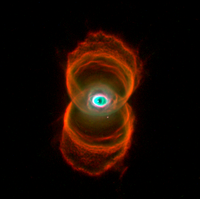astro.wikisort.org - Nebula
The Engraved Hourglass Nebula (also known as MyCn 18[2]) is a young planetary nebula in the southern constellation Musca. It was discovered by Annie Jump Cannon and Margaret W. Mayall during their work on an extended Henry Draper Catalogue (the catalogue was built between 1918 and 1924). At the time, it was designated simply as a small faint planetary nebula. Much improved telescopes and imaging techniques allowed the hourglass shape of the nebula to be discovered by Romano Coradi and Hugo Schwarz in images taken during 1991–1992 at the European Southern Observatory.[3] It is conjectured that MyCn 18's hourglass shape is produced by the expansion of a fast stellar wind within a slowly expanding cloud which is denser near its equator than its poles. The vivid colours given off by the nebula are the result of different 'shells' of elements being expelled from the dying star, in this case helium, nitrogen, oxygen and carbon.
| Emission nebula | |
|---|---|
| Planetary nebula | |
 1996 Hubble Space Telescope image of the Hourglass Nebula | |
| Observation data: J2000 epoch | |
| Right ascension | 13h 39m 35.116s[1] |
| Declination | −67° 22′ 51.45″[1] |
| Distance | 8,000 ly |
| Apparent magnitude (V) | 13.0[1] |
| Constellation | Musca |
| Physical characteristics | |
| Radius | - ly |
| Absolute magnitude (V) | - |
| Notable features | - |
| Designations | ESO 97-1,[1] Engraved Hourglass Nebula,[1] |
The Hourglass Nebula was photographed by the Wide Field and Planetary Camera 2 of the Hubble Space Telescope.
A less-famous "Hourglass Nebula" is located inside the Lagoon Nebula.
See also
References
- STScI. Hubble Finds an Hourglass Nebula around a Dying Star. Press release: Space Telescope Science Institute. January 16, 1996.
- "PN MyCn 18". SIMBAD. Centre de données astronomiques de Strasbourg. Retrieved 2006-12-22.
- MyCn stands for Margaret Walton Mayall (My) and Annie Jump Cannon (Cn), their 39-object catalogue was published in 1940 as New Peculiar Spectra in the Harvard College Observatory Bulletin, no. 913; Mayall has a later 139-object catalogue to her name, designated My: New Peculiar Spectra, Harvard College Observatory Bulletin, no. 920.
- Corradi, Romano L. M.; Schwarz, Hugo E. (1993). "Coradi & Schwarz (1993)". Astronomy and Astrophysics. 268: 714. Bibcode:1993A&A...268..714C.
На других языках
[de] Stundenglasnebel
Der Stundenglasnebel, auch Sanduhr-Nebel oder MyCn 18 genannt, ist ein planetarischer Nebel im Sternbild Fliege am Südsternhimmel und ist etwa 8.000 Lichtjahre von der Erde entfernt. Die Bezeichnung MyCn 18 stammt von Mayall und Cannon aus dem Jahr 1940.- [en] Engraved Hourglass Nebula
[es] Nebulosa Reloj de Arena
La nebulosa Reloj de Arena (MyCn 18) es una joven nebulosa planetaria en la constelación de Musca distante 8000 años luz de la Tierra. Fue descubierta por Annie Jump Cannon y Margaret W. Mayall cuando trabajaban sobre el catálogo de Henry Draper.[ru] Песочные Часы (туманность)
Песочные Часы (также известна как MyCn 18) — биполярная планетарная туманность, расстояние до которой составляет порядка 8000 световых лет. До сих пор до конца не ясно, что заставило туманность приобрести такую необычную форму, возможно она сформировалась из плотного газового облака в экваториальной плоскости центральной звезды туманности, которое под влиянием межзвёздного ветра приобрело видимую сейчас форму.Другой контент может иметь иную лицензию. Перед использованием материалов сайта WikiSort.org внимательно изучите правила лицензирования конкретных элементов наполнения сайта.
WikiSort.org - проект по пересортировке и дополнению контента Википедии